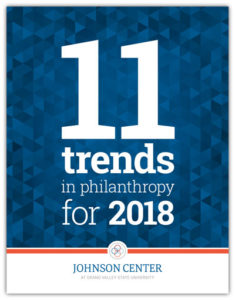Inclusivity Means Asking the Right Questions


 If “what gets measured, gets done,” then it is imperative that “what gets measured” is measured accurately and inclusively. As data-informed decision making becomes an ever-stronger practice in philanthropy, the field is paying increasing (if long overdue) attention to data collection, analysis, and dissemination methods that promote inclusivity and take cultural differences into account. Only when these efforts are in place can we expect effective actions and real impact for marginalized communities, as data will finally reflect the experiences they face.
If “what gets measured, gets done,” then it is imperative that “what gets measured” is measured accurately and inclusively. As data-informed decision making becomes an ever-stronger practice in philanthropy, the field is paying increasing (if long overdue) attention to data collection, analysis, and dissemination methods that promote inclusivity and take cultural differences into account. Only when these efforts are in place can we expect effective actions and real impact for marginalized communities, as data will finally reflect the experiences they face.
To meaningfully understand the needs of a population through data collection, surveying systems must accurately capture who the population is and be designed to best gather authentic information from them. It is critical that demographic questions, for example, do not alienate a population by demonstrating unawareness to cultural or identity norms. This is also key in data analysis, where misunderstandings or biases may lead to incorrect categorization of groups, inappropriate understanding of causal relationships, or inaccurate interpretations. In dissemination, too, these factors are equally important, as poor dissemination strategies can further “other” your target population or fail to reach them at all.
Inclusive data strategies will also help our sector better understand the complex makeup of the communities we work in. These efforts go beyond developing inclusive language or disaggregating results by race, gender, gender identity, sexual orientation, documentation status, substance use, or housing status, among others. They include intentionally asking each community or population whether surveyors are accurately understanding their identities and experiences in ways that do not stigmatize, minimize, or alienate. Ultimately, this work calls on researchers, evaluators, and philanthropic leaders to be more intentional in how they capture the authentic voices of stakeholders and ensure historically marginalized groups are not further marginalized.
Researchers are increasingly identifying useful strategies for those wishing to engage in this sort of intentional inclusivity; human-centered design, for instance, is gaining momentum as one such approach (e.g. Frederick, 2017). More generally, utilizing participatory methods — such as asking a community or population¬ what words they prefer to use to describe themselves or their experiences, or developing advisory or research committees that are comprised of people from the population of interest (Ostrow, Penney, Stuart, & Leaf, 2017; Kaiser, Thomas, Bowers, 2016) — can also increase the inclusivity of any study (Wallerstein, Duran, Minkler, & Oetzel, 2017; Vaughn, Jacquez, Lindquist-Grantz, Parsons, & Melink, 2016). Within participatory committees, of course, it is incumbent upon facilitators to pay close attention to power dynamics to ensure that all stakeholders have equal voice and the freedom to share that voice.
Overall, emerging best practice calls for data collectors to first share their results back with the community to make sure that outsiders are accurately understanding, synthesizing, and representing their experiences. Preparatory work within the philanthropic organization can also be extremely helpful in increasing knowledge of the target population, discovering and working through your own individual and organizational biases, and questioning historic practices that may unintentionally be exclusionary. At the end of the day, population research can be a complex and sensitive pursuit, and it is one that philanthropy is increasingly interested in approaching with intentional care.


Frederick, D. (2017). Putting ‘human-centered design’ to work against poverty [Podcast]. The Chronicle of Philanthropy. Retrieved from https://www.philanthropy.com/resources/audio/podcast-putting-human-center/6172/
Kaiser, B., Thomas, G., & Bowers, B. (2016). A case study of engaging hard-to-reach participants in the research process: Community advisors on research design and strategies (CARDS). Research in Nursing and Health 40(1), 70–79.
Ostrow, L., Penney, D., Stuart, E., & Leaf, P. (2017). Web-based survey data collection with peer support and advocacy organizations: Implications of participatory methods. Progress in Community Health Partnerships: Research Education, and Action 11(1), 45–52.
Vaughn, L., Jacquez, F., Lindquist-Grantz, R., Parsons, A., & Melink, K. (2016). Immigrants as research partners: A review of immigrants in community-based participatory research (CBPR). Journal of Immigrant and Minority Health 19(6), 1457–1468.
Wallerstein, N., Duran, B., Oetzel, J., Minkler, M. (2017, October 23). Community-Based Participatory Research for Health: Advancing Social and Health Equity (3rd ed.). San Francisco, CA: Jossey-Bass.